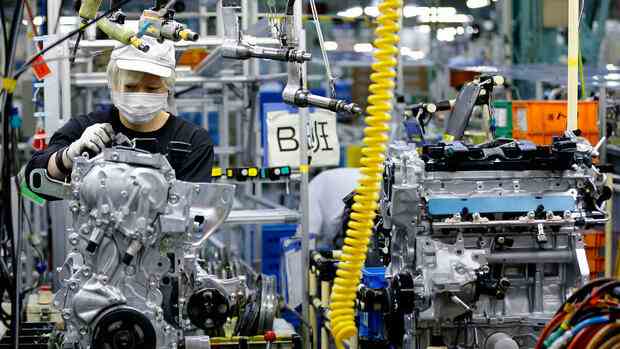The Japanese economy is still below the level before the corona pandemic.
(Photo: AP)
Tokyo The Japanese economy has still not fully recovered from the corona pandemic. Gross domestic product (GDP) growth slowed to 1.1 percent last year, the government said on Tuesday. In the previous year, the third largest economy in the world had grown by 2.1 percent.
The final quarter of 2022 was also unexpectedly restrained. Thanks to better consumption, GDP grew again after a negative quarter, but only with an increase of 0.6 percent. Economists had generally expected a better result. In contrast to the USA and other countries, Japan’s economic power is still below the level before the corona pandemic.
The figures come at a critical time in terms of economic policy: On Tuesday, Japan’s Prime Minister Fumio Kishida officially appointed the economist Kazuo Ueda as the new head of the central bank. Markets are looking to him to reform the aggressive monetary easing of incumbent Haruhiko Kuroda, who will step down in April after ten years. But Japan’s slow recovery from the corona crisis limits Ueda’s room for maneuver.
Kuroda’s monetary policy had reached its limits. At the start of his tenure in 2013, he drastically expanded purchases of Japanese government bonds. With the flood of money he wanted to achieve inflation of two percent.
In 2016 Kuroda then lowered the key interest rate to minus 0.1 percent and also introduced a control of the further yield curve. Ten-year Japanese government bonds (JGB) were only allowed to fluctuate by 0.25 percent around zero. But since central banks around the world have been raising interest rates to fight inflation, the Bank of Japan has had a harder time defending this interest rate corridor.
Inflation driven by high commodity prices
At the end of December 2022, Kuroda gave way and doubled the interest rate corridor to 0.5 percent. Since then, markets have been betting on two rate hikes this year. But the new head of the central bank, Ueda, does not seem to want a drastic change. On Friday, the theoretical pioneer of Japan’s zero interest rate policy described Japan’s loose monetary policy as “appropriate” given the economic situation.
>> Read here: Japan wants to become the third largest arms manufacturer after the USA and China
The problem for Japan’s monetary politicians is that inflation, currently around four percent, is being driven by higher prices for mostly imported commodities and not by domestic demand, as in other countries. According to Stefan Angrick, economist at Moody’s Analytics, the demand-driven price pressure is still “extremely low”.
For him it is therefore difficult to imagine “that the Bank of Japan under its new governor would rush into tightening monetary policy”. Higher interest rates could further slow down the weak domestic economic momentum.
>> Read here: Japan’s central bank shocks the markets with a change of course
But Angrick expects the central bank, under new leadership, to scale back or abandon Kuroda’s biggest monetary policy innovation, yield curve control. “The latter seems to us the more likely scenario,” says Angrick.
The reason: It would simplify the monetary policy framework and give the central bank “more leeway”. The Bank of Japan would no longer have to defend the upper limit of the interest rate corridor. But the era of JGB purchases would not be over, predicts the economist. “The Bank of Japan would remain active in the markets and curb the upward momentum in bond yields.” Finally, the central bank must take Japan’s debt service into consideration. National debt is more than 250 percent of economic power.
More: Japan’s new central bank chief: Kazuo Ueda has a difficult mission.
